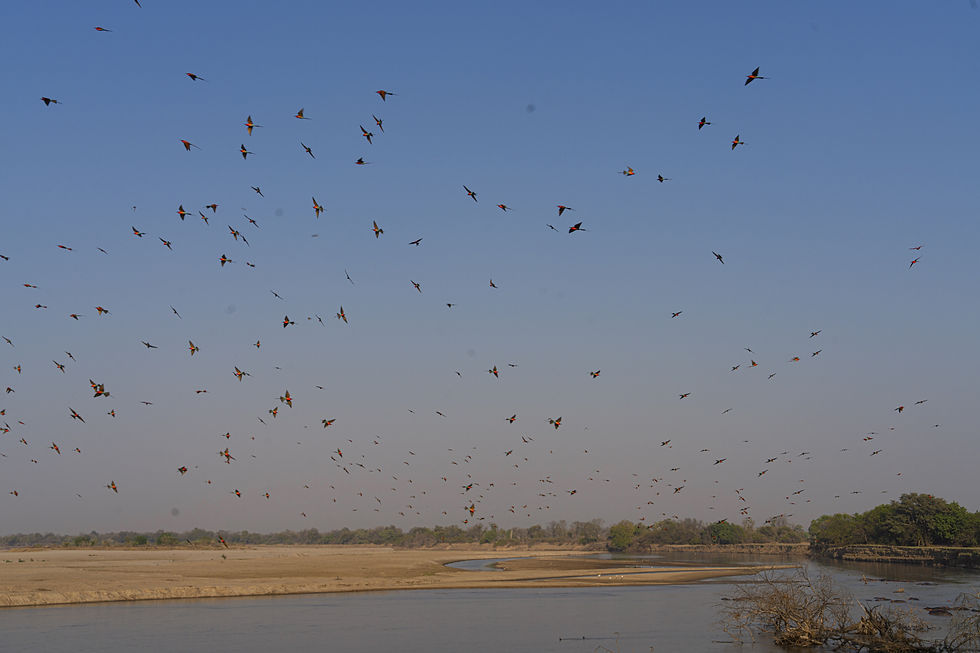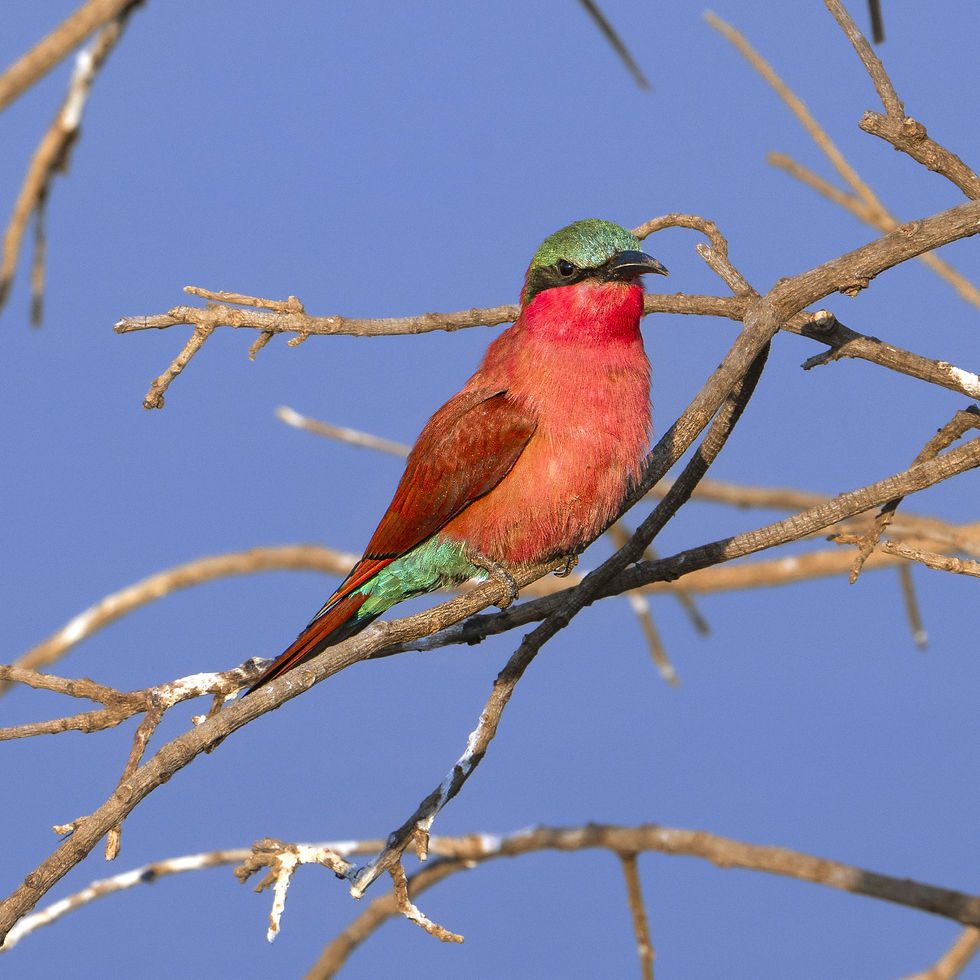At the Luangwa Part 1: Shawa Luangwa
- Ueli Huber
- Oct 28, 2023
- 7 min read
Updated: Jul 8, 2024

All pictures in all of the blogs from Zambia and Malawi are joint works
© Brigitte and Ueli Huber
Location: South Luangwa National Park (https://www.southluangwa.com)
Camp/Lodge: Shawa Luangwa, Green Safaris (www.greensafaris.com)
Und da sind wir! Unsere nächsten beiden Camps liegen im South Luangwa National Park, jeweils direkt am Luangwa, einem etwa 800 km langen Nebenfluss des selbst über 2500 km langen Zambezi, welcher der viertlängste Fluss Afrikas ist. Es hat Wasser – wir überqueren für unsere «Game Drives» und Walking Safaris den Fluss täglich mehrmals – aber mit dem Zambezi ist das dann schon nicht zu vergleichen. Der Wasserstand ist niedrig, an vielen Stellen ist das Flussbett ausgetrocknet. Es ist daher hier auch nicht möglich, Flussfahrten zu unternehmen. Dennoch möchten wir die Zeit am Luangwa aus verschiedenen Gründen nicht missen. Ihr werdet sehen!

And here we are! Our next two camps are in the South Luangwa National Park, each directly on the Luangwa, an approximately 800 km long tributary of the Zambezi (which itself is over 2500 km long and the fourth-longest river in Africa). It has water - we cross the river several times a day for our game drives and walking safaris -, but it is not comparable to the Zambezi. The water level is low, in many places the riverbed is dried up. Therefore it is not possible to do river cruises here. Nevertheless, we would not like to miss the time at the Luangwa for various reasons. You will see!
_____________________________
Der erwähnte Gattungsgenosse des Kupferschwanzkuckucks, der Weissbrauen-Spornkuckuck, war einer der ersten Vögel, den wir hier sahen. Er hielt sich an einer grossen Lagune auf, an der wir auf unseren Fahrten regelmässig vorbeikamen und wo sich auch viele andere Vögel aufhielten, nebst Hippos und anderem Wild. Das Wasser zieht unweigerlich an, insbesondere jetzt, am Ende der Trockenzeit.

The mentioned close relation of the Coppery-tailed Coucal, the White-browed Coucal, was one of the first birds we saw here. It stayed at a large lagoon that we passed regularly on our drives and where many other birds could be found, along with hippos and other game. The water inevitably attracts, especially now, at the end of the dry season.
In der Nähe hielten sich auch viele kleinere Vögel, Singvögel, auf. Besonders zu erwähnen ist der Blutschnabelweber. Abgebildet ist das unscheinbarere Weibchen. Ein weit farbigeres Männchen ist mir nicht vor die Linse geraten. Erwähnenswert ist dieses Vögelchen darum, weil ich kürzlich gelesen habe, dass es sich beim ihm wohl um den Vogel handelt, der – obwohl nur in Afrika vorkommend - der häufigste Vogel der Welt ist. Man schätzt seinen Bestand auf etwa 1,5 Milliarden. Die Weissbrauenweber gehören zur Familie der Weber, weisen aber auch Verwandschaft mit den Sperlingen auf. Und die Senegalamarante gehören zur grossen Familie der winzigen Prachtfinken mit über 120 Vertretern. In späteren Blogs gibt es dann Aufnahmen weiterer Familienangehöriger.



Nearby were also many smaller birds, songbirds mainly. Of particular note is the Red-billed Quelea. Pictured is the more inconspicuous female. A much more colorful male did not get in front of my lens. This bird is worth mentioning because I recently read that it is probably the most common bird in the world, although it is only found in Africa. Its population is estimated at about 1.5 billion. The White-browed Sparrow-weavers belong to the weaver family, but they are also somehow related to the sparrows. And the Red-billed Firefinch belongs to the large family of over 120 species of the tiny Estrildid Finches. In later blogs there will be pictures of other members of the family.
_____________________________
Dieser Rotte von Afrikanischen Wildhunden sind wir hier ein paarmal begegnet. Sie hielt sich tagsüber meist in der gleichen Gegend im Schatten auf. Anders als Katzen, die auch einmal ein paar Tage ohne Nahrung auskommen können, müssen die Wildhunde täglich jagen, um fressen zu könnnen. Wir werden im nächsten Camp darauf zurückkommen. Nicht weit von den Hunden hielt sich eine Tüpfelhyäne auf. Hyänen jagen zwar auch, aber diese hier versuchte wohl, von den Hunden etwas abzubekommen.


We encountered this pack of African Wild Dogs here a few times. It mostly stayed in the same area in the shade during the day. Unlike cats, which can go without food for a few days, Wild Dogs have to hunt daily in order to eat. We will come back to this in the next camp. Not far from the dogs was a Spotted Hyena. Hyenas hunt too, but this one was probably trying to get something from the dogs.


_____________________________
Die Erdbeerköpfchen (ehrlich gesagt – ich hab’s nicht immer mit den namengebenden deutschsprachigen Ornithologen) sind eine sehr kleine Art von Altwelt-Papageien. Man sieht das auf der Aufnahme nicht, aber sie sind kleiner als ein Haussperling!

The Lilian’s Lovebird is a very small species of Old-world Parrots. You can't see it in the shot, but they are smaller than a house sparrow!
_____________________________

Wir kennen bei uns nur den einen Eisvogel. Die Familie hat aber über 100 Arten. Wir haben einige wenige von ihnen im South Luangwa Nationalpark gesehen, so den Braunkopfliest, der schon im Lower Zambezi vorkam (bis 22cm), den Graufischer (bis 30cm) und den wesentlich grössere Riesenfischer (bis 46cm). Um sich ein Bild zu machen: Der Riesenfischer ist nur unwesentlich kleiner als unsere Saatkrähen (bis 50cm) und deutlich grösser als der Eichelhäher (bis 35cm). Im Laufe der Reise kamen dann noch zwei weitere Vertreter der Familie hinzu, beide der kleineren Art.

We know only one kingfisher in Europe. But the family has over 100 species. We have seen a few of them in the South Luangwa National Park, like the Brown-hooded Kingfisher, which was already present in the Lower Zambezi (up to 22cm), the Pied Kingfisher (up to 30cm) and the much bigger Giant Kingfisher (up to 46cm). To get an idea: The Giant Kingfisher is only slightly smaller than our Rooks (up to 50cm) and significantly larger than the Eurasian Jay (up to 35cm). In the course of the journey we met two more representatives of the family, both of the smaller kind.

____________________________
Die Nilgänse sind sich offensichtlich auch hier am Ausbreiten. Wir haben sie überall angetroffen. Sie werden in Sambia spasseshalber mittlerweile auch Sambia-Gänse genannt. Ausser ihnen und den Sporngänsen (mit einem Sporn am Ellenbogen zur Verteidigung) haben wir aber nicht sehr viele Entenvögel gesehen.

The Egyptian Geese are obviously spreading here as well. We met them everywhere. In Zambia they are called Zambia Geese as a joke. Except for them and the Spur-winged Geese (with a spur at the elbow for defense) we did not see many birds of that order.

_____________________________
Lassen wir ein paar Bilder ohne Kommentar Revue passieren. Die Flut an Eindrücken von Tieren, für uns ungewohnte Landschaften, Pflanzen, Farben und Gerüchen war überwältigend und wir möchten Euch etwas teilhaben lassen.
Let's view a few pictures without comment. The flood of impressions of animals, of for us unfamiliar landscapes, plants, colors and smells was overwhelming and we would like to share this with you.
















_____________________________
Ein besonderes Erlebnis war es, als wir auf einer Fahrt in eine Herde von Elefanten gerieten. Unser Führer hielt den Wagen an, als er die Herde vor uns sah, damit wir sie beobachten konnten. Es dauerte aber nicht lange, bis weitere Tiere von hinten aufschlossen und wir umzingelt waren. Es war alles ruhig. Die Tiere beobachteten uns ihrerseits, liessen sich aber nicht von ihren Verrichtungen abhalten.


It was a special experience when we ran into a herd of elephants on a drive. Our guide stopped the car when he saw the herd in front of us so we could watch them. It wasn't long, however, before more animals closed in from behind and we were surrounded. All was quiet. The animals observed us in turn, but did not let us stop them from doing what they needed to be doing.

Dass der Kleinste der Kleinen aus der Geborgenheit der Erwachsenen heraus schliesslich fast drohend seinen Rüssel hob, war allerdings sehr amüsant. Normalerweise werden die kleinen Elefanten sofort von einem alten Elefanten gedeckt, d.h. auf die der möglichen Bedrohung gegenüberliegende Seite genommen. Wir haben das unzählige Male beobachten können. Und es war anfänglich auch hier so. Aber die Tiere entspannten sich allmählich, und der kleine Wicht konnte sich hervorgetrauen. Er versuchte dann auch, es den Erwachsenen nachzutun und sich gegen Parasiten mit Sand zu bestreuen. Der Sand landete überall, nur nicht dort, wo er hingehörte!

The fact that the smallest of the little ones finally raised its trunk almost threateningly out of the security of the adults was, however, very amusing. Normally the young elephants are immediately covered by an old elephant, i.e. taken to the side opposite to a possible threat. We have been able to observe this countless times. And it was initially the same here. But the animals gradually relaxed, and the little runt was able to come out. He then also tried to imitate the adults and sprinkle himself with sand against parasites. The sand landed everywhere but where it belonged!

_____________________________

Und schliesslich: die Karminspinte. Sie sind ein Wahrzeichen des Luangwa, weshalb sie das Titelbild dieses Posts bilden. Diese Bienenfresser haben ein grosses Wintergebiet im nördlichen Zentralafrika (und ein kleineres im südlichen Afrika). Sie fliegen v.a. in den Monaten August und September südostwärts in eine verhältnismässig kleine Brutregion. Dazu gehört auch der Luangwa. Er bietet am Schluss der Trockenzeit bei tiefem Wasserstand viele sandige Böschungen, in welche die Bienenfresser ihre Bruthöhlen graben. Man kann dies auf der Aufnahme mit den Flusspferden gut erkennen. Die Ballung von Karminrot der besammelten Vögel gibt ein schier unglaubliches Bild ab.



And finally: the Southern Carmine Bee-eaters. They are a landmark of the Luangwa, which is why they are on the cover of this post. These bee-eaters have a large winter range in northern central Africa (and a smaller one in southern Africa). They fly southeast to a relatively small breeding region mainly in August and September. This includes the Luangwa. At the end of the dry season, when the water level is low, it offers many sandy banks in which the bee-eaters dig their breeding burrows. You can see the banks on the picture with the hippos. The agglomeration of crimson of the gathered birds gives an almost unbelievable picture.

_____________________________
Kurz nach dem Besuch der Spinte trafen wir in der Nähe des Flusses die ersten Giraffen dieser Reise an. Es waren nicht die letzten, aber sie sind nicht wirklich häufig anzutreffen und es gibt später keine Bilder mehr.


Shortly after visiting the bee-eaters, we encountered the first giraffes of this trip near the river. They were not the last, but they are not really common and there are no more pictures later.


_____________________________
Ein zierliches Kaptäubchen bildet schon fast den Abschluss dieses Posts. Wir befanden uns auf der Fahrt durch den Nationalpark und waren schon fast in der zweiten Lodge angekommen, als wir bei einer heissen Quelle einen Halt einlegen. Dort überflog uns auch der Heilige Ibis, der hier ebenso zum Wasser gehört wie andere Ibisse, Kiebitze und natürlich Hippos.

A petite Namaqua Dove is almost the conclusion of this post. We were on our way through the national park and had almost arrived at the second lodge when we stopped at a hot spring. There also the African Sacred Ibis flew over us, which bird belongs just as much to the water as other ibises, lapwings and naturally the hippos.

_____________________________
Wunderschöne Fotos! Absolutely amazing!😀
Unglaublich, eine so vielfältige Tierwelt. Wunderschöne Fotos !